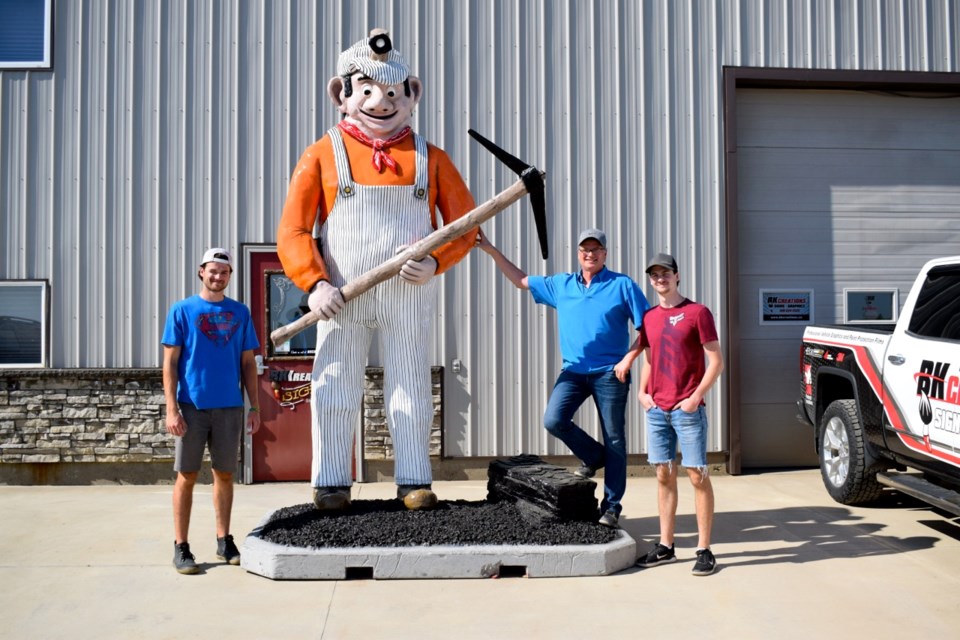Lignite Louie is back safe, and more sound than he's been for years.
Many community members may have noticed that the mascot disappeared from its usual location at the Estevan’s Oilfield Technical Society’s (OTS) Production Park, where for years it stood surrounded by oil industry elements. With it being originally made out of paper-mache, the rumours were that the funny statue was stolen to potentially decorate someone's backyard. However, Lignite Louie turned out to be heavier than expected and the reality was far from what the rumours said.
Norm Mack with the City of Estevan said that they noticed how badly the fragile construction had degraded and how abandoned it looked, so they took upon the project.
"We were at OTS Park with the pump jacks. The city painted all tanks and refurbished that. Then we looked over and there's Louie. And he's looking hidden behind trees and he's pretty sad looking, faded and peeling. And Jeff Ward (city manager) said, we should really do something about that. So we decided to get some prices and see who could do it," Mack said.
"The City of Estevan is honouring the coal workers by doing that," he added.
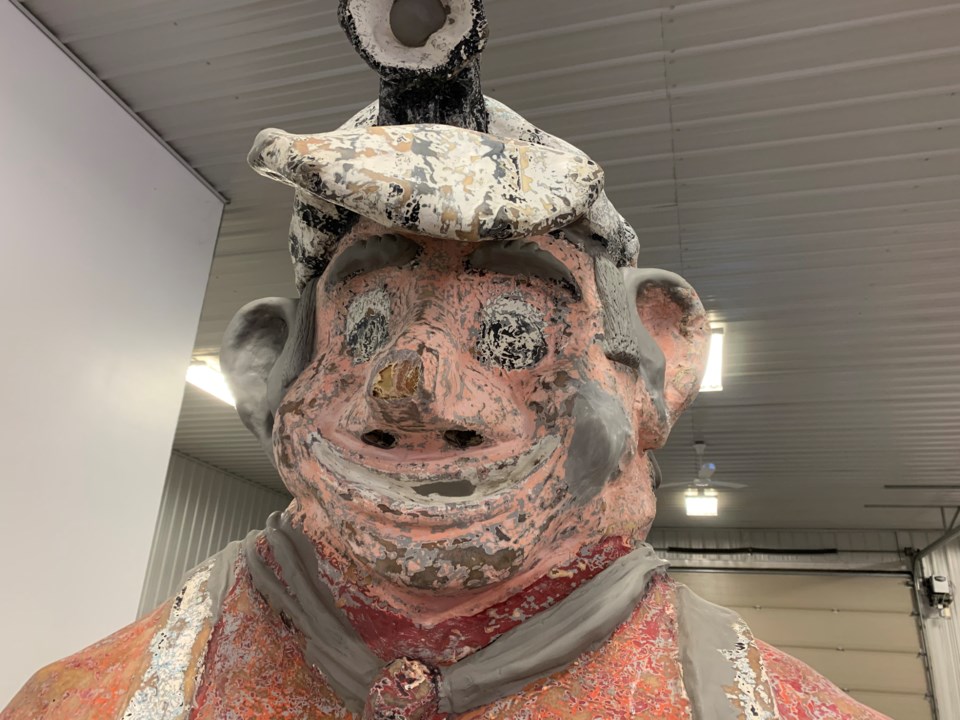
Nobody knew how much money and effort it would take to bring back to life the 50-year-old paper-mache miner that stands over 10 feet tall, was vandalized on several occasions, had legs broken once and has stayed outside for his entire life.
Blane Fichter with BK Creations has done some creative projects, where he built statues and compositions from scratch before. He saw Lignite Louie as somewhat of a challenge as he hasn't done any restorations of this kind. It made the project more interesting and attractive. The good old memories also pushed him towards taking on the project.
"I remember him as a kid. He stood by the old Civic Auditorium and they used to have Lignite Louie Days," shared Fichter.
Fichter's put a lot of work and research hours into the project. He found old pictures of Louie, and since the mascot was mimicking early day miners, Fichter also looked up some information about those who were Louie's prototypes.
The men that worked the mines in the early days in the Estevan-Bienfait area were mainly homesteaders, who would start working the land and raising small grain fields using money they made mining lignite, brown coal widespread in the area, to establish their farms. The only recognition they received for their hard work was the name, Lignite Louie.
Gradually, the technology took over the process, changing the roles and duties, but the biggest dragline still in use in the area was christened Big Lou out of respect of the hundreds of the coal miners that worked in the industry.
From 1977-80, older workers also received an official recognition as Lignite Louie Coal Miners of the year. (The list of names can be found in A Tale That is Told. Estevan 1890-1980, vol. 1).
Lignite Louie the mascot was created in 1971, and since that time was touched up a few times, however, no major refurbishment was done to it. When the decision to bring him back to life was made, no one really knew what would be upon them.
Outside of the original wear and tear, the big wind storm southeast Saskatchewan experienced in January this year broke Louie out of the pedestal that was holding him down. The paint on the outside wore out, and the materials inside rotted, so a full makeover was needed to ensure the mascot was good to go for many more years.
"When we got him we found two four-by-four wood posts (going) up his legs, and they had bolted that to the piece of plywood on the bottom. I thought, 'Well that's not going to stand any longer.' So we tried to pull them out of his legs and we couldn't, so then we had to cut a hole in his back and found he was full of newspapers and wire mesh," Fichter said.
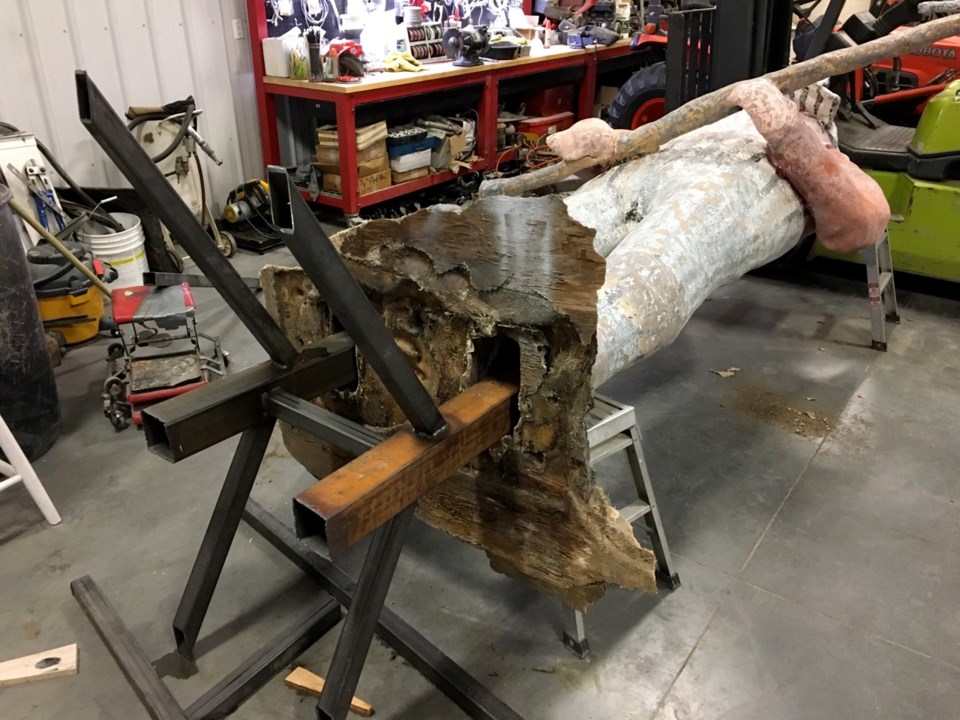
Once the old construction was out, a major steel structure was put into Louie's legs, which were then filled with expanding foam. The steel was later built into a new base, made out of a yard of fibre-reinforced concrete made look like a chunk of coal, which weighs over two tonnes (4,500 pounds).
Originally most of the detailing was done by paint, but Fichter wanted to ensure that even if the paint wears out, the next restorer will have some idea as to what Louie was like. So he used epoxy to give the mascot some hair, fingers, sleeves, boots, symmetric ears and more.
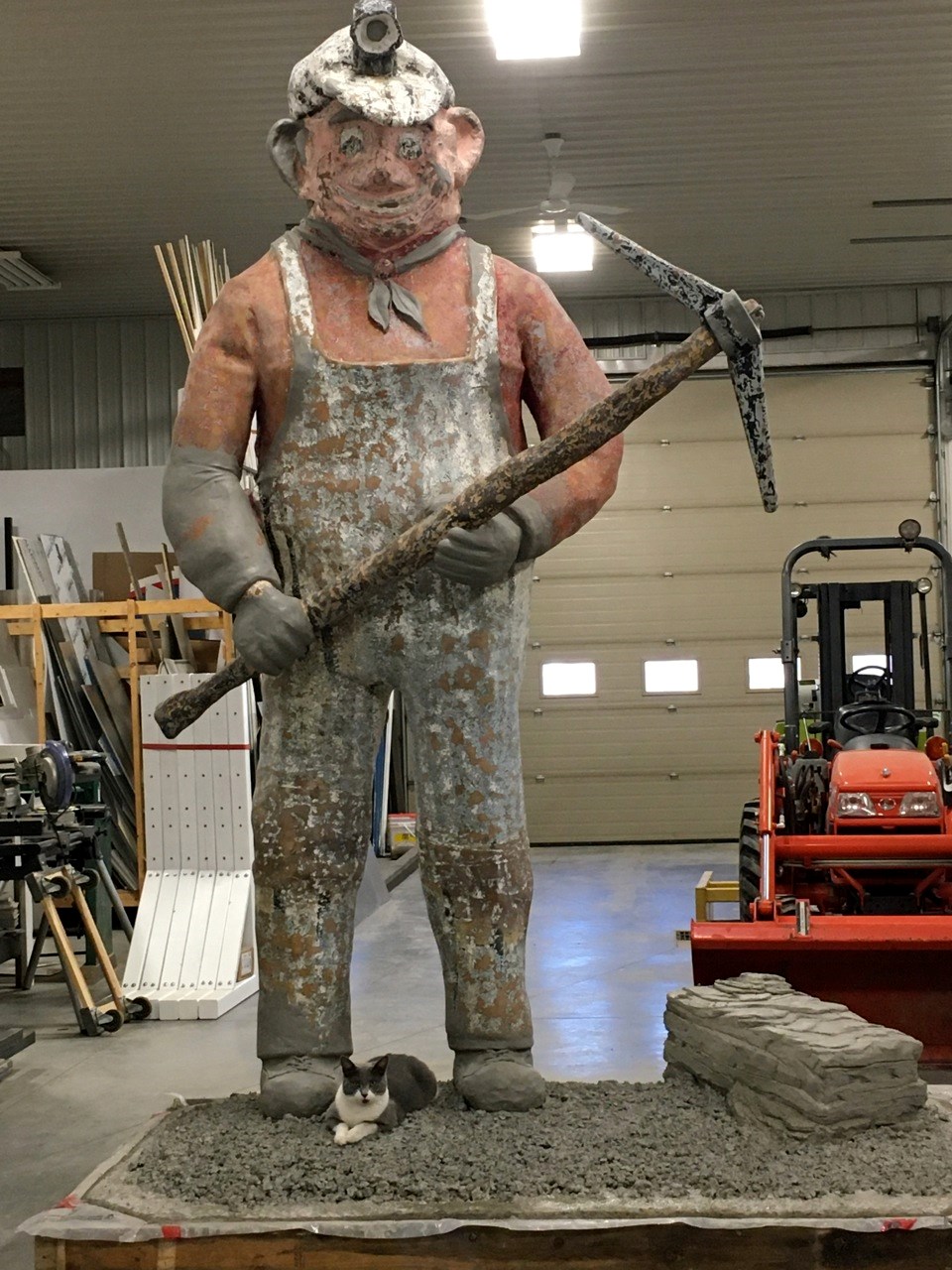
"I said, 'You know what, let's try and make him look as original as possible but fix him up. So we started hand sculpting different parts of him, giving him details … There's over three gallons of epoxy," Fichter said.
Fichter and his sons Jordan and Devin spent a lot of time fixing the construction, detailing and then painting the statue. With miles of pinstriping, Louie's coveralls turned into something more alike with what early days' miners wore in this area.
Once the project was completed, it was decided to move Louie to a new location where he would look and fit better.
"It was important with the talk of clean coal and all the workers I think at this point … to revitalize him and ... move him to the Souris Valley Museum on the 39 West in front of the mine display, so he's better suited out there," Mack said. "It'd be a good location for tourists' pictures."
Louie has yet to be installed at the museum.
The renewed construction is sturdy and bright, so Louie will make a great picture partner. Fichter said that the work they've done to the mascot should last at least 15 years before it needs to be touched up, and with a fresh clear coat every so often he will last indefinitely.
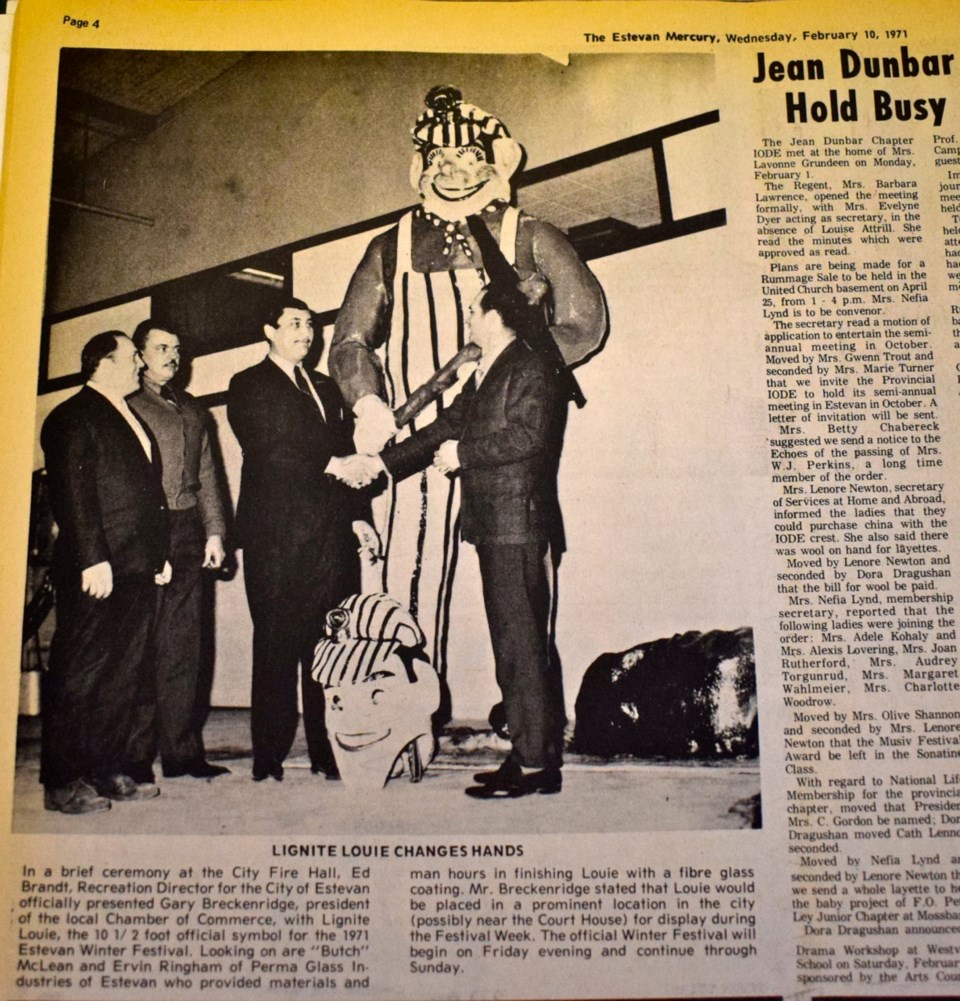
Starting in 1971, Lignite Louie was the property of the Estevan Chamber of Commerce. The character was a big part of the Lignite Louie winter festival – a popular event that many may remember from the 70s.
Vernon "Butch" McLean, the man behind the project shared that the mascot was created in voluntary co-operation between one of Estevan's major industries and the city’s recreation director as a new symbol of Saskatchewan's energy centre.
"Estevan, not to be outdone by some other communities in Canada, has been casting about for a symbol for some time. Noted as the coal, oil, natural gas and electrical power centre of the Prairies, many felt the city should have a method of impressing those facts upon visitors," wrote McLean in a document describing the project.
The decision to create Lignite Louie was inspired by the fact that in June 1970 the Saskatchewan Power Corporation (SPC) officially commissioned two new 150-megawatt generators to add to the already large Boundary Dam generating station, making it the largest lignite burning station in Canada.
"Paul Clothier, SPC's public relations department gave birth to Lignite Louie. Used as a symbol of the commissioning first, Clothier then presented his creation to the Chamber of Commerce in a number of drawings," continued McLean.
The idea was to depict an old-time miner. McLean who was the owner and general manager of Perma Glass Industries in Estevan, suggested he would make a large copy of Lignite Louie if he could find a mold. Edwin Brandt, the city’s recreation director, partially in his spare time decided to fashion in a mold out of the paper-mache. According to McLean's document, a total bill for materials, paid for by the Chamber of Commerce, came to about $35 including paint, chicken wire and plywood.
"It took two men to carry the figure into the Perma Glass Plant, and then after the shop crew had applied some $100 plus worth of fibreglass, it took six men to carry it out," McLean wrote.
He said that they enjoyed working on the project, and Perma Glass did it as a donation to the chamber.
The mold was spayed in sections, and as one section was rolled the crew went on to another. The whole figure received two coats. The original Lignite Louie stood 10 1/2 feet high and weighted some 350 pounds, not including the base where a large lump of lignite coal was placed just beside the figure and also covered with fibreglass for longevity.
Brandt then painted the statue after it was cured. Once finished the 1971 Lignite Louie had an orange shirt, light blue overalls and hat with broad black stripes, a blue polka dot neckerchief and handkerchief and black boots. The miner's lamp on the front of his head was gold-coloured.
Louie was built inside the old fire station on Third Street and had its permanent location by the Estevan Chamber of Commerce's old office on Fifth Street.
In addition to the large figure, Brandt constructed a Lignite Louie head, which Perma Glass Industries covered with fibreglass as well. The head was made to fit on the live Lignite Louie's shoulders.
"A great deal of advertising for the coming winter festival has been done by members of the chamber, using the head as a mobile symbol," said McLean.
While restoring Louie, Fichter found a hole and wires in his hat, which were added later to light up a bulb, but it wasn't working by the time of the restoration and was taken out.
